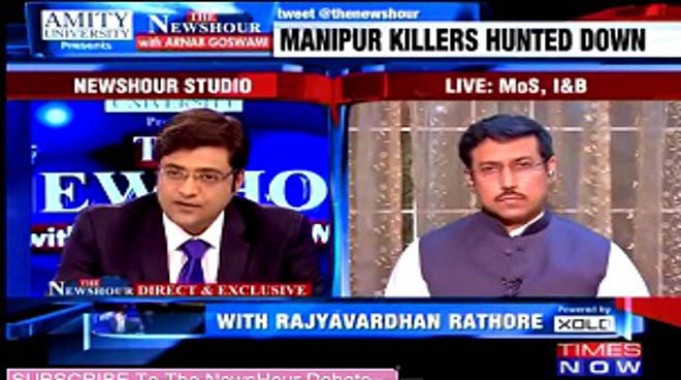Myanmar - a media operation?
As junior information minister Rajyavardhan Singh Rathore entered the Times Now studio, the complexion of the war changed.
The media seems to have taken over where the military left, says SUBIR BHAUMIK

Myanmar - a media operation?
The Indian para-commando strike into Myanmar, planned as an appropriate riposte to a rebel ambush that left 18 soldiers dead, has turned into a media farce. The wild claims of casualties in TV channels and newspapers -- some even claiming 150 militants dead -- have even embarrassed the military formations involved in the attack. A colonel in the 3rd Corps sent an SMS to me last night saying: “This has become a media operation". Clearly the media seems to have taken over where the military left.
Additional DGMO Maj-General Ranbir Singh in his June 9 press conference only claimed 'significant casualties' and avoided saying whether the strikes were inside Myanmar. Very cleverly, he suggested that but stuck to 'India-Myanmar border'. Again, he insisted that “we are in communication with Myanmar" without ever suggesting when they were informed of the assault. But as junior information minister Rajyavardhan Singh Rathore entered the Times Now studio, the complexion of the war changed. His claims of strikes 'deep inside Myanmar' were preposterous. Egged on by India's one and only media warrior Arnab Goswami, Rathore lost his military bearings and lent himself to Bollywood style sabre rattling. " This is a warning to all our neighbours who harbour terrorists," he said.
That not only provoked a furious response from Pakistan , uniting its feuding politicians and generals , who promised they were not Myanmar and dared India to try something like this on their territory. When it comes to a war of words, none in India or Pakistan wish to be left behind. At the end of the day, it became a media war, sending the mercury up on the already nose-diving India-Pakistan ties. The only explanation for Rathore's outbursts is that he is part of the BJP plan to whip up anti-Pakistan sentiments to get due dividends in the series of state elections in 2015-16. It had little to do with military realities -- a covert operation like a trans-border strike is successful and more such attacks can be launched only if they are kept secret.
Tripura police launched atleast 20 such raids on hideouts of ATTF and NLFT rebels in Bangladesh between 2000-05. A Military Intelligence colonel was even given the Chief Minister's Medal by CM Manik Sarkar in recognition of his great role in the covert attacks, in which surrendered militants and Bangladeshi mafiosi were used. Such action broke the back of ethnic tribal insurgency in Tripura. Only now the details are beginning to emerge when police chiefs start to speak up after retirement. But Manik Sarkar has kept his mouth shut on these raids, neither
acknowledging nor denying them . Whenever asked about how insurgency was tackled in his state, Sarkar profusely thanks Bangladesh PM Sheikh Hasina for her 'huge help in our fight against terror'.
The Indian media, specially the national TV channels and newspapers, have gone awry and haywire in reporting the trans-border strike into Myanmar. First, their claims of militant casualties are clearly way over the top. The army sources, when pushed, say "maybe 20 odd militants" may have been killed. The Home Ministry says 50. But many channels and papers have placed the casualty at between 100 to 150. The militant groups have denied that as 'completely baseless' and described them as an attempt to 'recover the image of the Indian forces'. While the militants claim only one Manipur PLA camp was attacked, media is reporting hits on 2 to 3 camps. The media is totally dependent on their sources in the defence and home ministries in Delhi -- people who have no knowledge of ground realities. Some have said the camps were located 2 kms inside Myanmar, some have put that at 5kms. That is not ''deep inside Myanmar" as Rathore had claimed. Myanmar has said the camps attacked were in Indian territory. That may be to avoid embarrassment but that may cost India dear in future engagements with Myanmar.
The casualty claims have varied so much -- one channel even came up with a definite figure of 38 militants killed as if their correspondent was down on ground counting bodies -- that they are no more credible. Commandos who could not use a smartphone camera to videograph the raid cannot be expected to count dead bodies ands provide a casualty count -- surely not if the whole operation was over in 45 minutes.
And if they were dropped by helicopters on the border and then trekked to hit the bases and finish it off in 45 minutes, they would have surely not gone very far inside Myanmar. It is not easy negotiating the Sagaing terrain, even for the toughest commandos. Which again means that if they were dropped not far from the rebel camps, the helicopter noise would have alerted the rebel sentries, foreclosing the possibility of a surprise raid?
Subir Bhaumik, a veteran BBC correspondent is author of two well acclaimed books on the Northeast, 'Insurgent Crossfire' and 'Troubled Periphery'.
Such articles are only possible because of your support. Help the Hoot. The Hoot is an independent initiative of the Media Foundation and requires funds for independent media monitoring. Please support us. Every rupee helps.
